Research Paper: Analysis of Emerging Technologies in Engineering
VerifiedAdded on 2022/10/18
|5
|1217
|10
Report
AI Summary
This report analyzes three emerging technologies: fuel cell vehicles, recyclable thermoset plastics, and neuromorphic technology. Fuel cell vehicles, powered by hydrogen, are presented as a zero-emission alternative, utilizing polymer electrolyte membrane fuel cells and regenerative braking. The report explores the rise of recyclable thermoset plastics as a solution to plastic waste, contrasting them with thermoplastics and highlighting recent advancements in their recyclability. Finally, it delves into neuromorphic technology, which aims to mimic the human brain for advanced artificial intelligence and computing, comparing it to traditional silicon chips, and mentioning large-scale neuromorphic projects.
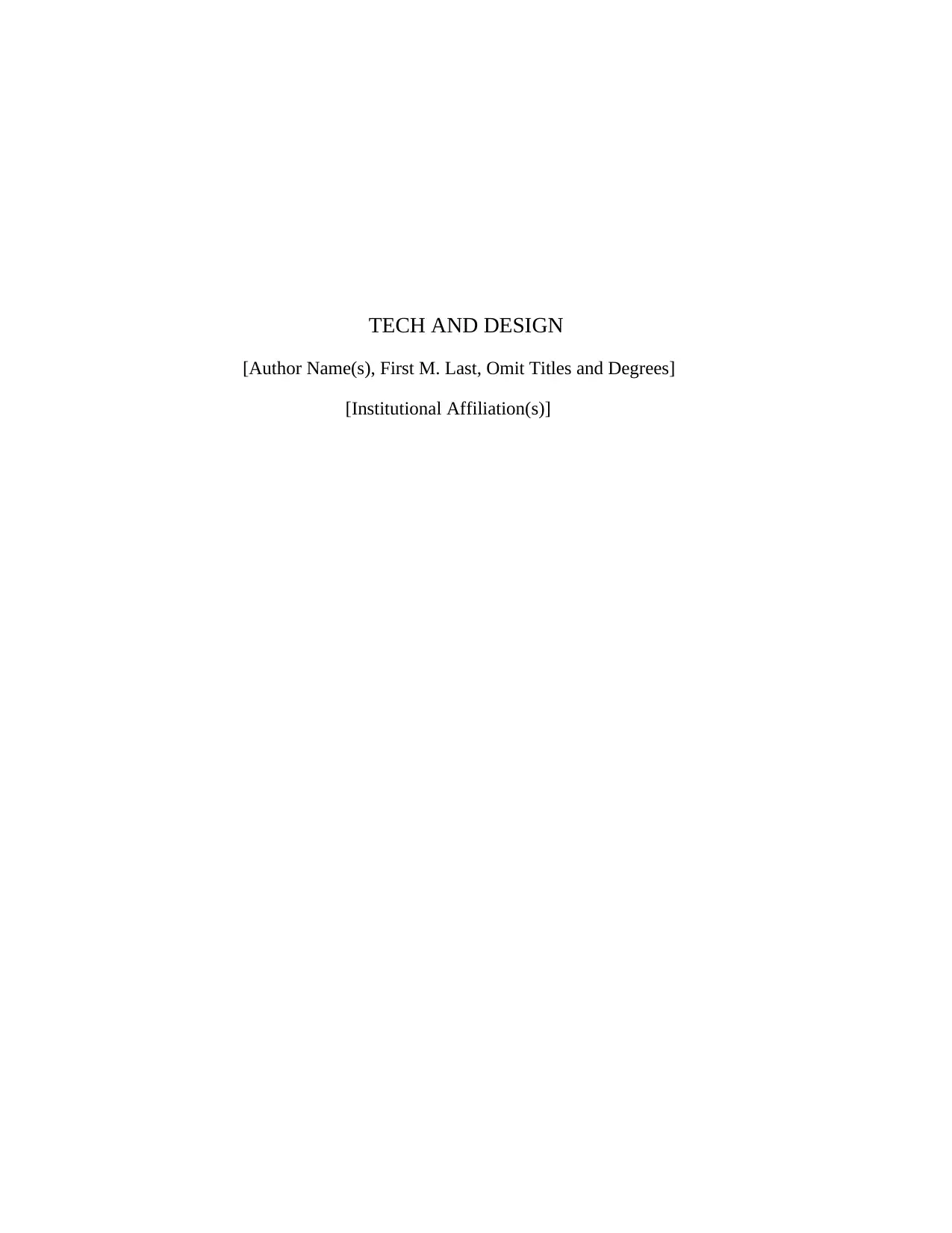
TECH AND DESIGN
[Author Name(s), First M. Last, Omit Titles and Degrees]
[Institutional Affiliation(s)]
[Author Name(s), First M. Last, Omit Titles and Degrees]
[Institutional Affiliation(s)]
Paraphrase This Document
Need a fresh take? Get an instant paraphrase of this document with our AI Paraphraser
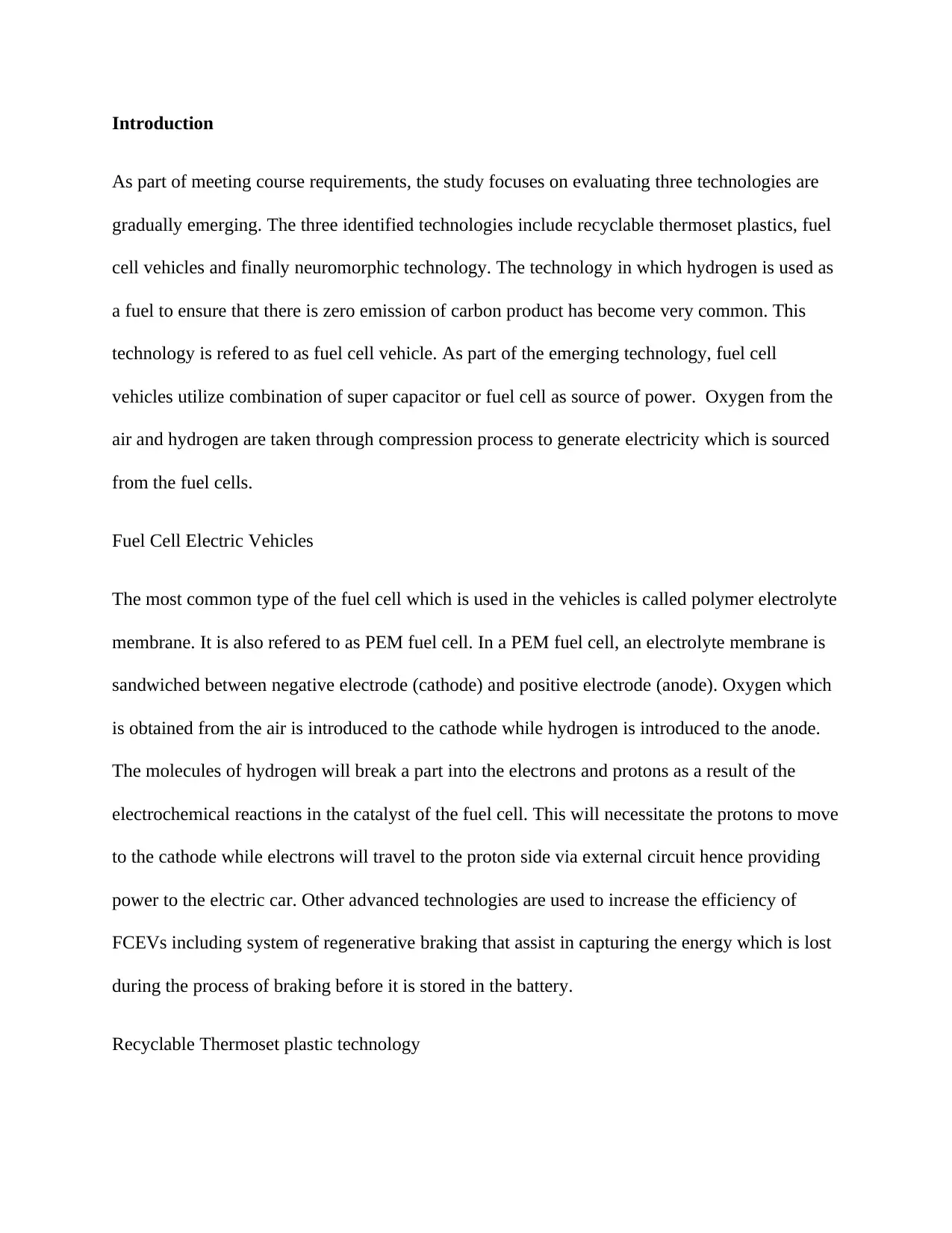
Introduction
As part of meeting course requirements, the study focuses on evaluating three technologies are
gradually emerging. The three identified technologies include recyclable thermoset plastics, fuel
cell vehicles and finally neuromorphic technology. The technology in which hydrogen is used as
a fuel to ensure that there is zero emission of carbon product has become very common. This
technology is refered to as fuel cell vehicle. As part of the emerging technology, fuel cell
vehicles utilize combination of super capacitor or fuel cell as source of power. Oxygen from the
air and hydrogen are taken through compression process to generate electricity which is sourced
from the fuel cells.
Fuel Cell Electric Vehicles
The most common type of the fuel cell which is used in the vehicles is called polymer electrolyte
membrane. It is also refered to as PEM fuel cell. In a PEM fuel cell, an electrolyte membrane is
sandwiched between negative electrode (cathode) and positive electrode (anode). Oxygen which
is obtained from the air is introduced to the cathode while hydrogen is introduced to the anode.
The molecules of hydrogen will break a part into the electrons and protons as a result of the
electrochemical reactions in the catalyst of the fuel cell. This will necessitate the protons to move
to the cathode while electrons will travel to the proton side via external circuit hence providing
power to the electric car. Other advanced technologies are used to increase the efficiency of
FCEVs including system of regenerative braking that assist in capturing the energy which is lost
during the process of braking before it is stored in the battery.
Recyclable Thermoset plastic technology
As part of meeting course requirements, the study focuses on evaluating three technologies are
gradually emerging. The three identified technologies include recyclable thermoset plastics, fuel
cell vehicles and finally neuromorphic technology. The technology in which hydrogen is used as
a fuel to ensure that there is zero emission of carbon product has become very common. This
technology is refered to as fuel cell vehicle. As part of the emerging technology, fuel cell
vehicles utilize combination of super capacitor or fuel cell as source of power. Oxygen from the
air and hydrogen are taken through compression process to generate electricity which is sourced
from the fuel cells.
Fuel Cell Electric Vehicles
The most common type of the fuel cell which is used in the vehicles is called polymer electrolyte
membrane. It is also refered to as PEM fuel cell. In a PEM fuel cell, an electrolyte membrane is
sandwiched between negative electrode (cathode) and positive electrode (anode). Oxygen which
is obtained from the air is introduced to the cathode while hydrogen is introduced to the anode.
The molecules of hydrogen will break a part into the electrons and protons as a result of the
electrochemical reactions in the catalyst of the fuel cell. This will necessitate the protons to move
to the cathode while electrons will travel to the proton side via external circuit hence providing
power to the electric car. Other advanced technologies are used to increase the efficiency of
FCEVs including system of regenerative braking that assist in capturing the energy which is lost
during the process of braking before it is stored in the battery.
Recyclable Thermoset plastic technology
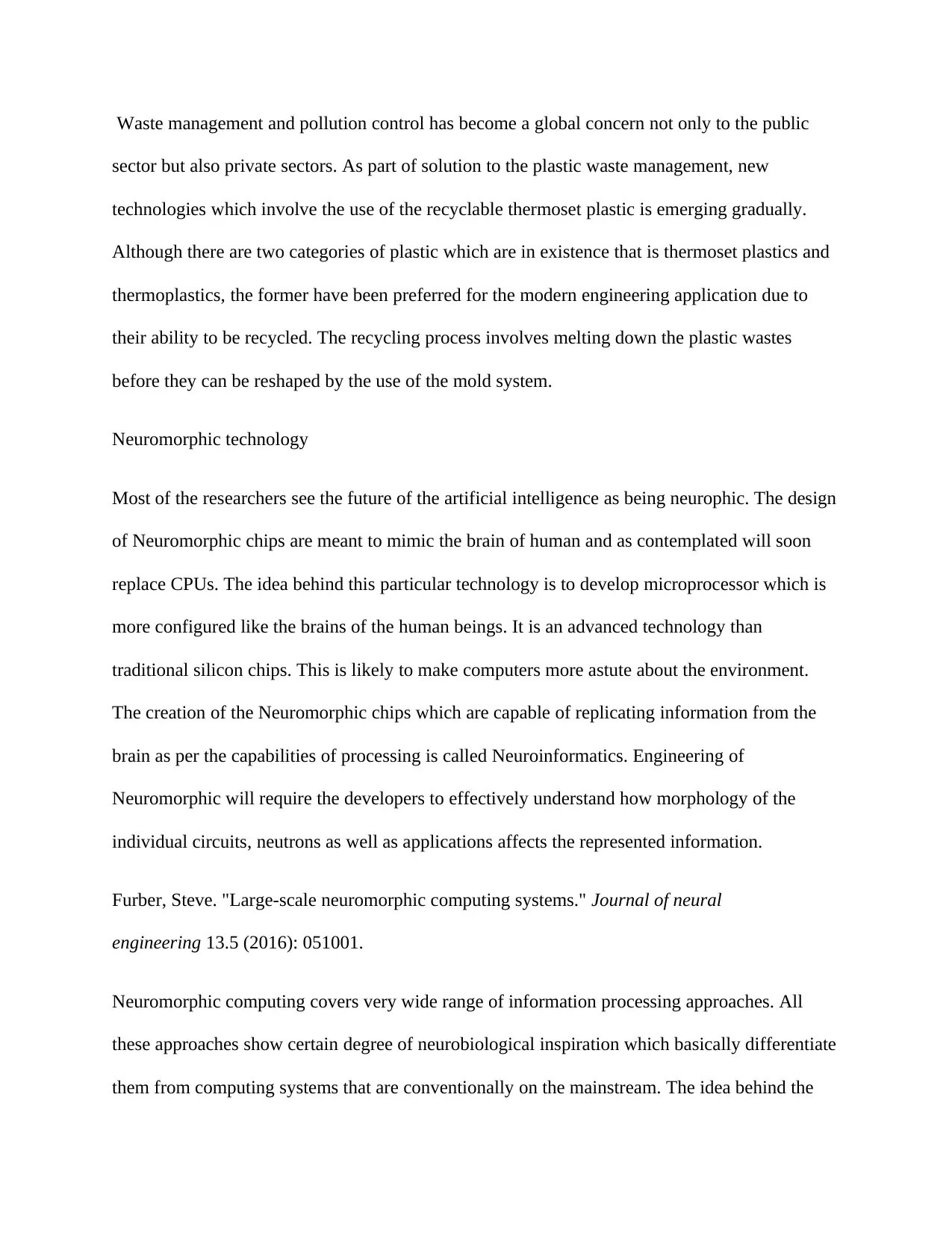
Waste management and pollution control has become a global concern not only to the public
sector but also private sectors. As part of solution to the plastic waste management, new
technologies which involve the use of the recyclable thermoset plastic is emerging gradually.
Although there are two categories of plastic which are in existence that is thermoset plastics and
thermoplastics, the former have been preferred for the modern engineering application due to
their ability to be recycled. The recycling process involves melting down the plastic wastes
before they can be reshaped by the use of the mold system.
Neuromorphic technology
Most of the researchers see the future of the artificial intelligence as being neurophic. The design
of Neuromorphic chips are meant to mimic the brain of human and as contemplated will soon
replace CPUs. The idea behind this particular technology is to develop microprocessor which is
more configured like the brains of the human beings. It is an advanced technology than
traditional silicon chips. This is likely to make computers more astute about the environment.
The creation of the Neuromorphic chips which are capable of replicating information from the
brain as per the capabilities of processing is called Neuroinformatics. Engineering of
Neuromorphic will require the developers to effectively understand how morphology of the
individual circuits, neutrons as well as applications affects the represented information.
Furber, Steve. "Large-scale neuromorphic computing systems." Journal of neural
engineering 13.5 (2016): 051001.
Neuromorphic computing covers very wide range of information processing approaches. All
these approaches show certain degree of neurobiological inspiration which basically differentiate
them from computing systems that are conventionally on the mainstream. The idea behind the
sector but also private sectors. As part of solution to the plastic waste management, new
technologies which involve the use of the recyclable thermoset plastic is emerging gradually.
Although there are two categories of plastic which are in existence that is thermoset plastics and
thermoplastics, the former have been preferred for the modern engineering application due to
their ability to be recycled. The recycling process involves melting down the plastic wastes
before they can be reshaped by the use of the mold system.
Neuromorphic technology
Most of the researchers see the future of the artificial intelligence as being neurophic. The design
of Neuromorphic chips are meant to mimic the brain of human and as contemplated will soon
replace CPUs. The idea behind this particular technology is to develop microprocessor which is
more configured like the brains of the human beings. It is an advanced technology than
traditional silicon chips. This is likely to make computers more astute about the environment.
The creation of the Neuromorphic chips which are capable of replicating information from the
brain as per the capabilities of processing is called Neuroinformatics. Engineering of
Neuromorphic will require the developers to effectively understand how morphology of the
individual circuits, neutrons as well as applications affects the represented information.
Furber, Steve. "Large-scale neuromorphic computing systems." Journal of neural
engineering 13.5 (2016): 051001.
Neuromorphic computing covers very wide range of information processing approaches. All
these approaches show certain degree of neurobiological inspiration which basically differentiate
them from computing systems that are conventionally on the mainstream. The idea behind the
⊘ This is a preview!⊘
Do you want full access?
Subscribe today to unlock all pages.

Trusted by 1+ million students worldwide
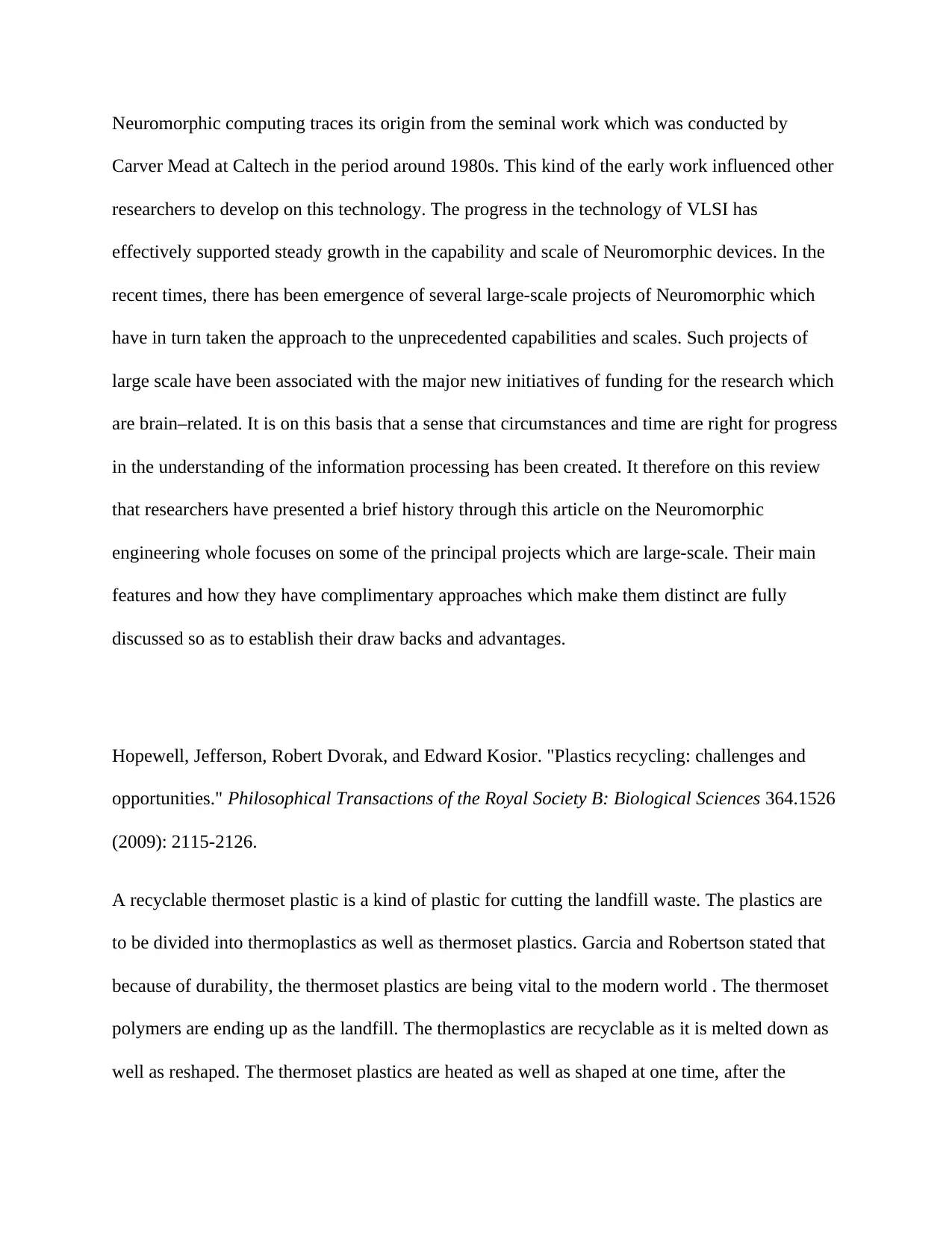
Neuromorphic computing traces its origin from the seminal work which was conducted by
Carver Mead at Caltech in the period around 1980s. This kind of the early work influenced other
researchers to develop on this technology. The progress in the technology of VLSI has
effectively supported steady growth in the capability and scale of Neuromorphic devices. In the
recent times, there has been emergence of several large-scale projects of Neuromorphic which
have in turn taken the approach to the unprecedented capabilities and scales. Such projects of
large scale have been associated with the major new initiatives of funding for the research which
are brain–related. It is on this basis that a sense that circumstances and time are right for progress
in the understanding of the information processing has been created. It therefore on this review
that researchers have presented a brief history through this article on the Neuromorphic
engineering whole focuses on some of the principal projects which are large-scale. Their main
features and how they have complimentary approaches which make them distinct are fully
discussed so as to establish their draw backs and advantages.
Hopewell, Jefferson, Robert Dvorak, and Edward Kosior. "Plastics recycling: challenges and
opportunities." Philosophical Transactions of the Royal Society B: Biological Sciences 364.1526
(2009): 2115-2126.
A recyclable thermoset plastic is a kind of plastic for cutting the landfill waste. The plastics are
to be divided into thermoplastics as well as thermoset plastics. Garcia and Robertson stated that
because of durability, the thermoset plastics are being vital to the modern world . The thermoset
polymers are ending up as the landfill. The thermoplastics are recyclable as it is melted down as
well as reshaped. The thermoset plastics are heated as well as shaped at one time, after the
Carver Mead at Caltech in the period around 1980s. This kind of the early work influenced other
researchers to develop on this technology. The progress in the technology of VLSI has
effectively supported steady growth in the capability and scale of Neuromorphic devices. In the
recent times, there has been emergence of several large-scale projects of Neuromorphic which
have in turn taken the approach to the unprecedented capabilities and scales. Such projects of
large scale have been associated with the major new initiatives of funding for the research which
are brain–related. It is on this basis that a sense that circumstances and time are right for progress
in the understanding of the information processing has been created. It therefore on this review
that researchers have presented a brief history through this article on the Neuromorphic
engineering whole focuses on some of the principal projects which are large-scale. Their main
features and how they have complimentary approaches which make them distinct are fully
discussed so as to establish their draw backs and advantages.
Hopewell, Jefferson, Robert Dvorak, and Edward Kosior. "Plastics recycling: challenges and
opportunities." Philosophical Transactions of the Royal Society B: Biological Sciences 364.1526
(2009): 2115-2126.
A recyclable thermoset plastic is a kind of plastic for cutting the landfill waste. The plastics are
to be divided into thermoplastics as well as thermoset plastics. Garcia and Robertson stated that
because of durability, the thermoset plastics are being vital to the modern world . The thermoset
polymers are ending up as the landfill. The thermoplastics are recyclable as it is melted down as
well as reshaped. The thermoset plastics are heated as well as shaped at one time, after the
Paraphrase This Document
Need a fresh take? Get an instant paraphrase of this document with our AI Paraphraser
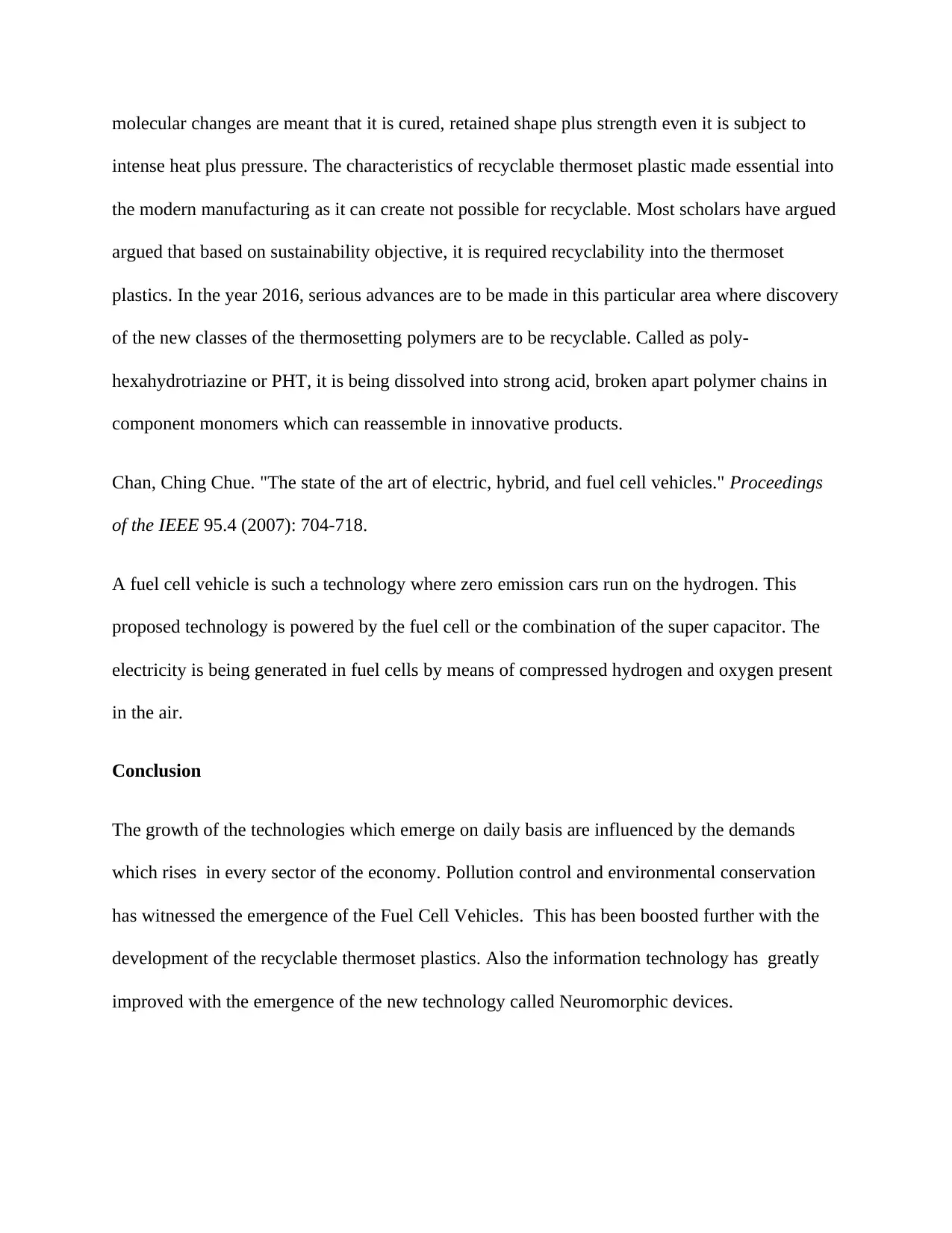
molecular changes are meant that it is cured, retained shape plus strength even it is subject to
intense heat plus pressure. The characteristics of recyclable thermoset plastic made essential into
the modern manufacturing as it can create not possible for recyclable. Most scholars have argued
argued that based on sustainability objective, it is required recyclability into the thermoset
plastics. In the year 2016, serious advances are to be made in this particular area where discovery
of the new classes of the thermosetting polymers are to be recyclable. Called as poly-
hexahydrotriazine or PHT, it is being dissolved into strong acid, broken apart polymer chains in
component monomers which can reassemble in innovative products.
Chan, Ching Chue. "The state of the art of electric, hybrid, and fuel cell vehicles." Proceedings
of the IEEE 95.4 (2007): 704-718.
A fuel cell vehicle is such a technology where zero emission cars run on the hydrogen. This
proposed technology is powered by the fuel cell or the combination of the super capacitor. The
electricity is being generated in fuel cells by means of compressed hydrogen and oxygen present
in the air.
Conclusion
The growth of the technologies which emerge on daily basis are influenced by the demands
which rises in every sector of the economy. Pollution control and environmental conservation
has witnessed the emergence of the Fuel Cell Vehicles. This has been boosted further with the
development of the recyclable thermoset plastics. Also the information technology has greatly
improved with the emergence of the new technology called Neuromorphic devices.
intense heat plus pressure. The characteristics of recyclable thermoset plastic made essential into
the modern manufacturing as it can create not possible for recyclable. Most scholars have argued
argued that based on sustainability objective, it is required recyclability into the thermoset
plastics. In the year 2016, serious advances are to be made in this particular area where discovery
of the new classes of the thermosetting polymers are to be recyclable. Called as poly-
hexahydrotriazine or PHT, it is being dissolved into strong acid, broken apart polymer chains in
component monomers which can reassemble in innovative products.
Chan, Ching Chue. "The state of the art of electric, hybrid, and fuel cell vehicles." Proceedings
of the IEEE 95.4 (2007): 704-718.
A fuel cell vehicle is such a technology where zero emission cars run on the hydrogen. This
proposed technology is powered by the fuel cell or the combination of the super capacitor. The
electricity is being generated in fuel cells by means of compressed hydrogen and oxygen present
in the air.
Conclusion
The growth of the technologies which emerge on daily basis are influenced by the demands
which rises in every sector of the economy. Pollution control and environmental conservation
has witnessed the emergence of the Fuel Cell Vehicles. This has been boosted further with the
development of the recyclable thermoset plastics. Also the information technology has greatly
improved with the emergence of the new technology called Neuromorphic devices.
1 out of 5
Your All-in-One AI-Powered Toolkit for Academic Success.
+13062052269
info@desklib.com
Available 24*7 on WhatsApp / Email
![[object Object]](/_next/static/media/star-bottom.7253800d.svg)
Unlock your academic potential
Copyright © 2020–2025 A2Z Services. All Rights Reserved. Developed and managed by ZUCOL.


